| Listing 1 - 10 of 11 | << page >> |
Sort by
|

ISBN: 3540261559 3540261621 3540316000 3540316019 Year: 2005 Volume: 187-188 Publisher: Berlin, Heidelberg : Springer Berlin Heidelberg : Imprint: Springer,
Abstract | Keywords | Export | Availability | Bookmark
 Loading...
Loading...Choose an application
- Reference Manager
- EndNote
- RefWorks (Direct export to RefWorks)
Polymers --- Polymères --- Chemistry. --- Polymers. --- Soft condensed matter. --- Polymer Sciences. --- Soft Matter, Complex Fluids. --- Macromolecules --- Deformations (Mechanics) --- Molecular dynamics --- Organic Chemistry --- Chemistry --- Physical Sciences & Mathematics --- Fracture --- Amorphous substances. --- Complex fluids. --- Soft and Granular Matter, Complex Fluids and Microfluidics. --- Polymères --- EPUB-LIV-FT SPRINGER-B --- Complex liquids --- Fluids, Complex --- Polymere --- Polymeride --- Polymers and polymerization --- Dynamics, Molecular --- Physical sciences --- Amorphous substances --- Liquids --- Soft condensed matter --- Polymers .
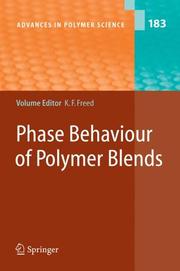
ISBN: 9783540256809 3540256806 354031394X Year: 2005 Publisher: Berlin, Heidelberg : Springer Berlin Heidelberg : Imprint: Springer,
Abstract | Keywords | Export | Availability | Bookmark
 Loading...
Loading...Choose an application
- Reference Manager
- EndNote
- RefWorks (Direct export to RefWorks)
Polymers --- Phase rule and equilibrium. --- Loi des phases et équilibre --- Mixing --- Phase rule and equilibrium --- Organic Chemistry --- Chemistry --- Physical Sciences & Mathematics --- Mixing. --- Polymere --- Polymeride --- Polymers and polymerization --- Chemistry. --- Polymers. --- Amorphous substances. --- Complex fluids. --- Polymer Sciences. --- Soft and Granular Matter, Complex Fluids and Microfluidics. --- Complex liquids --- Fluids, Complex --- Amorphous substances --- Liquids --- Soft condensed matter --- Macromolecules --- Physical sciences --- Polymers .
Book
ISBN: 9783540232483 3540232486 9786610305148 1280305142 3540270760 Year: 2005 Publisher: Berlin : Springer,
Abstract | Keywords | Export | Availability | Bookmark
 Loading...
Loading...Choose an application
- Reference Manager
- EndNote
- RefWorks (Direct export to RefWorks)
LIFE - as a Matter of Fat Lipidomics is the science of the fats called lipids. Lipids are as important for life as proteins, sugars, and genes. The present book gives a multi-disciplinary perspective on the physics of life and the particular role played by lipids and the lipid-bilayer component of cell membranes. The book is aimed at undergraduate students and young research workers within physics, chemistry, biochemistry, molecular biology, nutrition, as well as pharmaceutical and biomedical sciences. The emphasis is on the physical properties of lipid membranes seen as soft and molecularly structured interfaces. By combining and synthesizing insights obtained from a variety of recent studies, an attempt is made to clarify what membrane structure is and how it can be quantitatively described. Furthermore, it is shown how biological function mediated by membranes is controlled by lipid membrane structure and organization on length scales ranging from the size of the individual molecule, across molecular assemblies of proteins and lipid domains in the range of nanometers, to the size of whole cells. Applications of lipids in nano-technology and biomedicine are also described. The Emerging Science of Lipidomics We have just witnessed a scientific revolution at the end of the 20th century that took us through the genomics era with a focus on sequencing genes and mapping gene products. We are now in the middle of the proteomics era where the multitude of proteins that are encoded in the genes are identified and their functions are unveiled. In front of us we have a new era recognizing the role of lipids. The science of lipidomics is emerging. Lipidomics involves a quantitative experimental and theoretical study of, e.g. lipid and membrane self-assembly, lipid-protein interactions, lipid-gene interactions, and the biophysical properties of lipid structure, function, and dynamics. .
Lipids --- Lipides --- Fat. --- Lipids. --- Lipid membranes --- Fatty acids --- Chemicals and Drugs --- Biology --- Human Anatomy & Physiology --- Health & Biological Sciences --- Animal Biochemistry --- Biophysics --- Metabolism --- Physiological effect --- Biomolecules. --- EPUB-LIV-FT LIVPHYSI SPRINGER-B --- Biological molecules --- Lipins --- Lipoids --- Physics. --- Food --- Polymers. --- Biochemistry. --- Amorphous substances. --- Complex fluids. --- Biophysics. --- Biological physics. --- Materials --- Thin films. --- Biophysics and Biological Physics. --- Biochemistry, general. --- Polymer Sciences. --- Soft and Granular Matter, Complex Fluids and Microfluidics. --- Food Science. --- Surfaces and Interfaces, Thin Films. --- Biotechnology. --- Surfaces. --- Molecules --- Molecular biology --- Biomolecules --- Steroids

ISBN: 9783540265801 3540265805 9783540269021 3540269029 3540316027 3540316035 Year: 2005 Publisher: Berlin, Heidelberg : Springer Berlin Heidelberg : Imprint: Springer,
Abstract | Keywords | Export | Availability | Bookmark
 Loading...
Loading...Choose an application
- Reference Manager
- EndNote
- RefWorks (Direct export to RefWorks)
Block copolymers. --- Copolymères séquencés --- Chemistry. --- Chemistry, Physical organic. --- Polymers. --- Soft condensed matter. --- Polymer Sciences. --- Physical Chemistry. --- Soft Matter, Complex Fluids. --- Block copolymers --- Organic Chemistry --- Chemistry --- Physical Sciences & Mathematics --- Block polymers --- Polymere --- Polymeride --- Polymers and polymerization --- Chemistry, Physical organic --- Physical chemistry. --- Amorphous substances. --- Complex fluids. --- Soft and Granular Matter, Complex Fluids and Microfluidics. --- Macromolecules --- Physical sciences --- Complex liquids --- Fluids, Complex --- Amorphous substances --- Liquids --- Soft condensed matter --- Chemistry, Theoretical --- Physical chemistry --- Theoretical chemistry --- Chemistry, Organic --- Chemistry, Physical and theoretical --- Polymers .
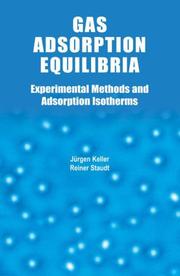
ISBN: 1280148012 9786610148011 0387235981 0387235973 1441936408 Year: 2005 Publisher: New York : Springer,
Abstract | Keywords | Export | Availability | Bookmark
 Loading...
Loading...Choose an application
- Reference Manager
- EndNote
- RefWorks (Direct export to RefWorks)
This book is intended to present for the first time experimental methods to measure equilibria states of pure and mixed gases being adsorbed on the surface of solid materials. It has been written for engineers and scientists from industry and academia who are interested in adsorption-based gas separation processes and/or in using gas adsorption for characterization of the porosity of solid materials. Traditional and new measurement methods for gas adsorption equilibria are presented in Chaps. 2-6 and elucidated by quite a number of experimental data sets, most of them having been measured in the authors' laboratories. Special emphasis is given to uncertainties of data and pros and cons of all measurement methods are offered. Also the basic concepts underlying interpretation of measurements and calculations of adsorbed masses from measurement signals, are discussed in Chap. 1. The authors state that in publishing this book they "hope to contribute to... the development of effective and reliable methods to measure pure gas and gas mixture adsorption equilibria; preventing young (and old) experimenters from doing all the mistakes we have done during our laboratory work*) ; making experimental gas adsorption data measured today in many laboratories more easily comparable to each other, as methods and procedures should become more and more similar and possibly also will be standardized (IUPAC) in the years to come. ".
Gases --- Gas-solid interfaces. --- Thermodynamics. --- Absorption and adsorption. --- Absorption --- Adsorption --- Chemistry, Physical and theoretical --- Dynamics --- Mechanics --- Physics --- Heat --- Heat-engines --- Quantum theory --- Solid-gas interfaces --- Interfaces (Physical sciences) --- Chemical engineering. --- Surfaces (Physics). --- Industrial Chemistry/Chemical Engineering. --- Soft and Granular Matter, Complex Fluids and Microfluidics. --- Surfaces and Interfaces, Thin Films. --- Chemistry, Industrial --- Engineering, Chemical --- Industrial chemistry --- Engineering --- Chemistry, Technical --- Metallurgy --- Surface chemistry --- Surfaces (Technology) --- Amorphous substances. --- Complex fluids. --- Materials—Surfaces. --- Thin films. --- Films, Thin --- Solid film --- Solid state electronics --- Solids --- Coatings --- Thick films --- Complex liquids --- Fluids, Complex --- Amorphous substances --- Liquids --- Soft condensed matter

ISBN: 1280308338 9786610308330 038726213X 0387241760 1441936998 Year: 2005 Publisher: New York : Springer,
Abstract | Keywords | Export | Availability | Bookmark
 Loading...
Loading...Choose an application
- Reference Manager
- EndNote
- RefWorks (Direct export to RefWorks)
This multi-author volume provides a useful summary of updated knowledge on polymer composites, practically integrating experimental studies, theoretical analyses and computational modeling at different scales, i.e. from nano- to macro- scale. Detailed consideration is given to four major areas: Part I deals with the structure and properties of nanocomposites. Part II focuses on some special characterization methods and modeling in the field of polymer composites. Processing and applications of macrocomposites makes up Part III, and Part IV deals with mechanical performance of macrocomposoites.
Polymeric composites. --- Reinforced plastics. --- Composite materials --- Plastics --- Polyesters --- Composite polymeric materials --- Polymer-matrix composites --- Reinforced plastics --- Polymers. --- Materials. --- Nanotechnology. --- Polymer Sciences. --- Materials Science, general. --- Soft and Granular Matter, Complex Fluids and Microfluidics. --- Ceramics, Glass, Composites, Natural Materials. --- Molecular technology --- Nanoscale technology --- High technology --- Engineering --- Engineering materials --- Industrial materials --- Engineering design --- Manufacturing processes --- Polymere --- Polymeride --- Polymers and polymerization --- Macromolecules --- Materials --- Polymers . --- Materials science. --- Amorphous substances. --- Complex fluids. --- Ceramics. --- Glass. --- Composites (Materials). --- Composite materials. --- Composites (Materials) --- Multiphase materials --- Reinforced solids --- Solids, Reinforced --- Two phase materials --- Material science --- Physical sciences --- Amorphous substances --- Ceramics --- Glazing --- Ceramic technology --- Industrial ceramics --- Keramics --- Building materials --- Chemistry, Technical --- Clay --- Complex liquids --- Fluids, Complex --- Liquids --- Soft condensed matter

ISBN: 1402036620 1402036639 9786610624362 1280624361 1402036590 Year: 2005 Volume: 206 Publisher: Dordrecht ; [London] : Springer,
Abstract | Keywords | Export | Availability | Bookmark
 Loading...
Loading...Choose an application
- Reference Manager
- EndNote
- RefWorks (Direct export to RefWorks)
Recently there have been profound developments in the understanding and interpretation of liquids and soft matter centered on constituents with sho- range interactions. Ionic soft matter is a class of conventional condensed soft matter with prevailing contribution from electrostatics and, therefore, can be subject to possible long-range correlations among the components of the - terial and in many cases crucially affecting its physical properties. Among the most popular representatives of such a class of materials are natural and synthetic saline environments, like aqueous and non-aqueous electrolyte - lutions and molten salts as well as variety of polyelectrolytes and colloidal suspensions. Equally well known are biological systems of proteins. All these systems are examples of soft matter strongly in?uenced, if not dominated, by long-range forces. For more than half of century the classical theories by Debye and Hückel as well as by Derjaguin, Landau, Verwey and Owerbeek (DLVO) have been at the basis of theoretical physical chemistry and chemical engineering. The substantial progress in material science during last few decades as well as the advent of new instrumentation and computational techniques made it apparent that in many cases the classical theories break down. New types of interactions (e.g. hydrodynamic, entropic) have been discovered and a number of questions have arisen from theoretical and experimental studies. Many of these questions still do not have de?nite answers.
Ionic solutions --- Soft condensed matter --- Matière molle (Physique) --- Solutions ioniques --- Congresses --- Congresses. --- Congrès --- Soft condensed matter. --- Atomic Physics --- Physics --- Physical Sciences & Mathematics --- Matière molle (Physique) --- Congrès --- EPUB-LIV-FT LIVPHYSI SPRINGER-B --- Solutions, Ionic --- Physics. --- Physical chemistry. --- Condensed matter. --- Amorphous substances. --- Complex fluids. --- Biophysics. --- Biological physics. --- Soft and Granular Matter, Complex Fluids and Microfluidics. --- Condensed Matter Physics. --- Physical Chemistry. --- Biophysics and Biological Physics. --- Ions --- Solution (Chemistry) --- Condensed matter --- Matter, Soft (Condensed matter) --- Matter, Soft condensed --- Soft matter (Condensed matter) --- Complex fluids --- Chemistry, Physical organic. --- Biological and Medical Physics, Biophysics. --- Chemistry, Physical organic --- Chemistry, Organic --- Chemistry, Physical and theoretical --- Biological physics --- Biology --- Medical sciences --- Chemistry, Theoretical --- Physical chemistry --- Theoretical chemistry --- Chemistry --- Condensed materials --- Condensed media --- Condensed phase --- Materials, Condensed --- Media, Condensed --- Phase, Condensed --- Liquids --- Matter --- Solids --- Complex liquids --- Fluids, Complex --- Amorphous substances
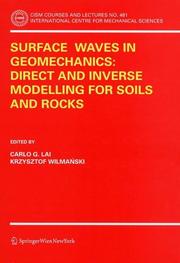
ISBN: 9783211380659 3211277404 9783211277409 3211380655 Year: 2005 Publisher: Vienna : Springer Vienna : Imprint: Springer,
Abstract | Keywords | Export | Availability | Bookmark
 Loading...
Loading...Choose an application
- Reference Manager
- EndNote
- RefWorks (Direct export to RefWorks)
Theories of surface waves develop since the end of XIX century and many fundamental problems like existence, phase and group velocities, attenuation (quality factor), mode conversion, etc. have been, in part successfully, solved within the framework of such simple models as ideal fluids^ or linear elasticity. However, a sufficiently complete presentation of this subject, particularly for solids, is still missing in the literature. The sole exception is the book of I. A. Viktorov^ which contains an extensive discussion of fundamental properties of surface waves in homogeneous and stratified linear elastic solids with particular emphasis on contributions of Russian scientists. Unfortunately, the book has never been translated to English and its Russian version is also hardly available. Practical applications of surface waves develop intensively since a much shorter period of time than theories even though the motivation of discoverers of surface waves such as Lord Rayleigh stems from their appearance in geophysics and seismology. Nowadays the growing interest in practical applications of surface waves stem from the following two main factors: surface waves are ideal for developing relatively cheap and convenient methods of nondestructive testing of various systems spanning from nanomaterials (e.g.
Engineering. --- Continuum Mechanics and Mechanics of Materials. --- Applied Geosciences. --- Mechanics. --- Granular Media. --- Acoustics. --- Software Engineering. --- Software engineering. --- Physics. --- Materials. --- Ingénierie --- Génie logiciel --- Mécanique --- Physique --- Acoustique --- Matériaux --- Rayleigh waves. --- Rock mechanics. --- Soil mechanics. --- Surface waves. --- Engineering & Applied Sciences --- Chemical & Materials Engineering --- Applied Mathematics --- Materials Science --- Soil engineering --- Soils --- Soils (Engineering) --- Mechanics --- Geotechnical engineering. --- Amorphous substances. --- Complex fluids. --- Continuum mechanics. --- Geotechnical Engineering & Applied Earth Sciences. --- Soft and Granular Matter, Complex Fluids and Microfluidics. --- Geotechnical engineering --- Acoustic surface waves --- Elastic waves --- Fluid dynamics --- Geodynamics --- Seismic waves --- Foundations --- Soil physics --- Surface waves (Oceanography) --- Gravity waves --- Surface energy --- Mechanics, Applied. --- Solid Mechanics. --- Classical Mechanics. --- Computer software engineering --- Engineering --- Applied mechanics --- Engineering, Mechanical --- Engineering mathematics --- Classical mechanics --- Newtonian mechanics --- Physics --- Dynamics --- Quantum theory --- Complex liquids --- Fluids, Complex --- Amorphous substances --- Liquids --- Soft condensed matter --- Engineering, Geotechnical --- Geotechnics --- Geotechnology --- Engineering geology
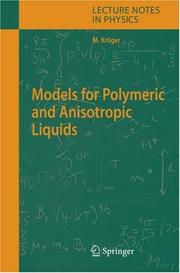
ISBN: 9783540262107 3540262105 3540315195 Year: 2005 Publisher: Berlin, Heidelberg : Springer Berlin Heidelberg : Imprint: Springer,
Abstract | Keywords | Export | Availability | Bookmark
 Loading...
Loading...Choose an application
- Reference Manager
- EndNote
- RefWorks (Direct export to RefWorks)
Models should be as simple as possible, but no simpler. For the physics of polymeric liquids, whose relevant lengths and time scales are out of reach for first principles calculations, this means that we have to choose a minimum set of sufficiently detailed descriptors such as architecture (linear, ring, branched), connectivity, semiflexibility, stretchability, excluded volume, and hydrodynamic interaction. These 'universal' fluids allow the prediction of material properties under external flow- or electrodynamic fields, the results being expressed in terms of reference units, specific for any particular chosen material. This book provides an introduction to the kinetic theory and computer simulation methods needed to handle these models and to interpret the results. Also included are a number of sample applications and computer codes.
Polymer solutions --- Crystalline polymers --- Mathematical models. --- Organic Chemistry --- Atomic Physics --- Physics --- Chemistry --- Physical Sciences & Mathematics --- Mathematical models --- Crystal polymers --- Crystallographically ordered polymers --- Polymer crystals --- Liquid polymers --- Polymeric liquids --- Physics. --- Polymers. --- Continuum physics. --- Amorphous substances. --- Complex fluids. --- Continuum mechanics. --- Soft and Granular Matter, Complex Fluids and Microfluidics. --- Polymer Sciences. --- Classical Continuum Physics. --- Numerical and Computational Physics. --- Continuum Mechanics and Mechanics of Materials. --- Mechanics of continua --- Elasticity --- Mechanics, Analytic --- Field theory (Physics) --- Complex liquids --- Fluids, Complex --- Amorphous substances --- Liquids --- Soft condensed matter --- Classical field theory --- Continuum physics --- Continuum mechanics --- Polymere --- Polymeride --- Polymers and polymerization --- Macromolecules --- Natural philosophy --- Philosophy, Natural --- Physical sciences --- Dynamics --- Mechanics. --- Mechanics, Applied. --- Classical and Continuum Physics. --- Numerical and Computational Physics, Simulation. --- Solid Mechanics. --- Applied mechanics --- Engineering, Mechanical --- Engineering mathematics --- Classical mechanics --- Newtonian mechanics --- Quantum theory --- Polymers .
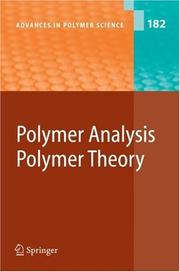
ISBN: 9783540255482 3540255486 3540315772 Year: 2005 Volume: 182 Publisher: Berlin ; Heidelberg : Springer,
Abstract | Keywords | Export | Availability | Bookmark
 Loading...
Loading...Choose an application
- Reference Manager
- EndNote
- RefWorks (Direct export to RefWorks)
Polymerization --- Polymers --- Polymérisation --- Polymères --- Analysis --- Analyse --- Analytical Chemistry --- Organic Chemistry --- Chemistry --- Physical Sciences & Mathematics --- Polymerization. --- Analysis. --- Polymere --- Polymeride --- Polymers and polymerization --- Polymerisation --- Synthesis of polymers --- Synthesis --- Chemistry. --- Analytical chemistry. --- Physical chemistry. --- Polymers. --- Chemistry, Physical and theoretical. --- Amorphous substances. --- Complex fluids. --- Statistical physics. --- Dynamical systems. --- Polymer Sciences. --- Analytical Chemistry. --- Physical Chemistry. --- Theoretical and Computational Chemistry. --- Statistical Physics, Dynamical Systems and Complexity. --- Soft and Granular Matter, Complex Fluids and Microfluidics. --- Dynamical systems --- Kinetics --- Mathematics --- Mechanics, Analytic --- Force and energy --- Mechanics --- Physics --- Statics --- Mathematical statistics --- Complex liquids --- Fluids, Complex --- Amorphous substances --- Liquids --- Soft condensed matter --- Chemistry, Theoretical --- Physical chemistry --- Theoretical chemistry --- Macromolecules --- Analysis, Chemical --- Analytical chemistry --- Chemical analysis --- Metallurgical analysis --- Mineralogy, Determinative --- Physical sciences --- Statistical methods --- Analytical biochemistry. --- Chemistry, Physical organic. --- Complex Systems. --- Chemistry, Physical organic --- Chemistry, Organic --- Chemistry, Physical and theoretical --- Analytic biochemistry --- Biochemistry --- Chemistry, Analytic --- Bioanalytic chemistry --- Bioanalytical chemistry --- Polymers . --- Analytic chemistry --- Chemical reactions
| Listing 1 - 10 of 11 | << page >> |
Sort by
|

 Search
Search Feedback
Feedback About UniCat
About UniCat  Help
Help News
News